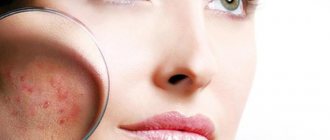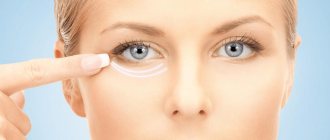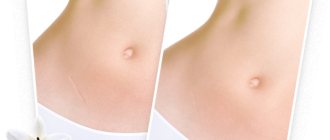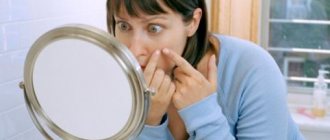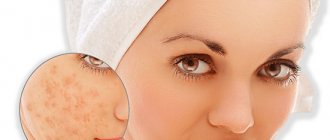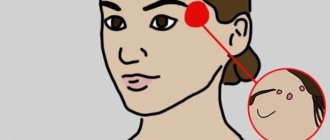- How to get rid of acne bruises?
- How to remove bruises after acne using home methods?
For many sufferers of past or present acne and pimples, once they are completely cleared, the prospect of living without scars, scars or bruises can easily lead to a trip to the esthetician's office for cosmetic procedures, chemical peels or creams to help with acne bruises.
While these treatments can produce immediate and powerful results, they also come with a long list of side effects. For those who want to find a safe alternative to get rid of the scars and bruises left by pimples and acne, we suggest trying some of the remedies and treatments presented first below:
Bruises after acne
Typically, spots on the skin form after fairly serious acne. But sometimes even single inflamed acne leaves behind blue and purple marks. Such skin pigmentation is quite normal and is mainly explained by:
- Persistent damage to small vessels in areas of inflammation.
- Excessive accumulation of melanin pigment in the affected areas.
- Impaired collagen production in the area of inflamed areas. In this case, in addition to blueness, areas of bumpiness also appear on the skin.
The marks that remain from rashes on the body are called “post-acne”. Cosmetologists and dermatologists will most effectively tell you how to get rid of bruises after acne.
Rehabilitation after liposculpture
Body liposculpture allows you to instantly get rid of “fat traps”, recreate an athletic profile and compensate for the lack of soft tissue volume (enlarge your breasts, buttocks). Liposculpture includes liposuction and lipofilling and is a minimally invasive operation (without incisions), since the surgeon performs all manipulations with a special cannula through small punctures in the skin. Our clinic has installed the latest vibration liposuction device PAL Liposculptor
, which makes such a serious and complex operation as gentle as possible - it eliminates damage to blood vessels, extensive hematomas, and bumps on the skin.
However, rehabilitation after liposculpture of the body cannot be called simple, especially if the plastic surgeon worked on more than 2 zones. After the operation, it is important to wear compression garments
, temporarily give up sports training (later it is not only possible to return to it, but it is highly desirable - to consolidate the result) and follow other doctor’s recommendations.
Anti-bruise creams
At home, it is quite possible to combat post-acne in the form of bruises using a variety of creams:
- With hydroquinone. This element has pronounced whitening properties; it is able to stop the production of melanin, restoring the skin's even tone and elasticity. Similar products can be purchased at the pharmacy, including Lierac Hydra-Chrono, Nadinola, and Astramin. It is very important to remember that when using such creams it is necessary to take special care to protect the skin from ultraviolet radiation.
- With AHA acids, for example, glycolic, lactic, citric or salicylic. Such drugs are gentler and may have fewer side effects. Creams with them deeply moisturize, neutralize inflammation, have an antioxidant effect and activate collagen production. And they actually make acne bruises less noticeable.
- With azelaic acid. This substance is included in many products intended for the treatment of skin ailments. This acid has a lot of useful qualities; it can interrupt the production of melanin in the epidermis, providing a lightening effect. Creams with azelaic acid have accumulative qualities; tangible results from their use become noticeable after about a month. Among drugs of this type are Aknestop, Azelik, the famous Skinoren, Azogel, etc.
- With substances that can suppress melanin synthesis. Such cream components can be represented by kojic acid, magnesium ascorbyl-2-phosphate, as well as arbutin, etc. You can purchase such cosmetics in a pharmacy or online.
Usually, acne bruise lightening creams need to be used daily for a certain period of time - about two months. After a short break of two to three weeks, it is advisable to repeat the course of therapy.
The face of an alcoholic: signs
The term “alcoholic face” is widely used in the medical industry. This concept implies a complex of the most characteristic features of the appearance of a person who abuses alcohol. Inexhaustible libations have a negative impact on all systems and organs. The result is the appearance of the following specific appearance features:
Deepening of the nasolabial fold in the upper part. At the same time, its lower part becomes smoother, which emphasizes the difference.
- The appearance of noticeable folds at the inner corner of the eyes. As a result, the organs of vision look more sunken.
- Nostril expansion. The nose swells, becomes deformed, and increases in size. Wrinkles appear on the bridge of the nose, diverging in an oblique direction.
- Thickening of lips. The outlines of this part of the face change. Due to the relaxation of the round muscle of the mouth, the lips are closed all the time.
The characteristic redness of the face is another striking sign of the appearance of an alcoholic. Regular consumption of alcohol in large doses leads to a decrease in the elasticity of blood vessels and capillaries and a violation of their integrity. As a result, spider veins appear on the face.
Violation of water-salt metabolism and the rate of elimination of excess fluid is reflected in the appearance in the form of edema. Together with a decrease in skin turgor, this leads to the appearance of dark circles and bags under the eyes. An additional factor is the relaxation of the circular muscles in this area, which also contributes to the formation of swelling. The face of a chronic alcoholic acquires characteristic swelling. Ultimately, this is fraught with the loss of the original outlines. The oval of the face becomes indistinct, as if blurred.
The outer layer of the epidermis dries out, peeling appears, and the face takes on an unhealthy hue. The consequence of addiction is early deep wrinkles. Constantly tense frontal muscles lead to pathological changes in the face, which becomes drooping and elongated.
All the described manifestations become more noticeable as the disease develops. Timely treatment of alcoholism can slow down negative processes in the body. However, regular, excessive and intense consumption of alcohol leaves an indelible mark on one’s appearance. Representatives of the fair sex are especially susceptible to this. Dehydration in women manifests itself more clearly and occurs much faster, which is associated with the characteristic features of female metabolism.
Salon treatments
Experienced cosmetologists, answering the question of how to remove bruises from acne, recommend several sessions of fairly simple procedures that differ in the degree of effect on the skin:
- Peeling. If it is necessary to eliminate only small hematomas, only one such procedure may be sufficient. If post-acne marks are superficial, peeling will easily make the skin smooth, even out the tone and have a good rejuvenating effect. To perform this procedure, different acids can be used; cosmetologists often prefer glycolic and retinoic acid, Jessner's solution, etc.
- Microcurrent therapy. When performing this procedure, the cosmetologist acts on the client’s skin with currents of ultra-low amplitude and frequency, due to which facial muscles, lymphatic and circulatory systems are stimulated, and collagen production processes and other regenerative mechanisms are activated. Microcurrents effectively tighten the skin, eliminate minor imperfections and post-acne marks.
- Fractional photothermolysis. During this procedure, the client's skin is exposed to laser microbeams, which cause the destruction of old cells, weakened fibroblasts and keratinocytes that make up the stratum corneum of the epidermis. As a result of a session of fractional photothermolysis, intensive skin renewal, active synthesis of young and healthy cells, and the production of new collagen and elastin molecules occur. The procedure very effectively smoothes out surface defects, which include post-acne marks.
- Laser resurfacing. This technique consists of evaporating skin cells with a laser beam and, in comparison with all of the above, it is considered quite traumatic for the skin. However, when post-acne spots are located superficially, the laser has no effect on the deep layers of the epidermis and gives a truly excellent result with minimal recovery time. But medial resurfacing, of course, is a more serious procedure and requires lengthy rehabilitation.
Only a cosmetologist can determine which acne removal procedure will be truly effective in each specific case.
The specialist will also provide the most detailed information about the features of preparation for treatment and the rules of rehabilitation after it.
Rehabilitation after facial plastic surgery
Rehabilitation after a facelift (facelift), liposculpture and blepharoplasty is individual, but as practice shows, tissue restoration takes 2-3 weeks
.
During this period, bruises
and slight
swelling
, which increases
2-3 days
after surgery. Pain usually does not bother you and does not interrupt you from rest and daily activities; it can be reduced with the help of mild painkillers prescribed by your plastic surgeon. There is no need to worry about scars after a facelift and blepharoplasty - they are hidden in the natural folds of the skin or under the hair, and over time they will become invisible. If, during recovery after facial plastic surgery, a patient has an individual tendency towards hypertrophic, keloid, atrophic scars or the tissue healing process does not go entirely smoothly, cryodestruction of the scar, lipofilling or injection cosmetology comes to the rescue. Plastic surgeons at the Pirogov Clinic are always in touch with their patients. The key to successful recovery after facial plastic surgery is to follow all the doctor’s recommendations: for a while you need to give up warm baths, solariums, alcohol and smoking.
Getting rid of it at home
Small hematomas on the skin can be dealt with at home. In principle, minor acne marks can go away on their own, and various treatment methods only speed up this process. Let's look at how to get rid of acne bruises on your own:
- Green clay. This natural substance has mild whitening properties. To prepare a remedy for post-acne, you need to take 1 tbsp. l. clay powder and dilute with cool water to a thick paste. Add literally 1-2 drops to the mass. rosemary essential oil. Apply the mixture to problem areas for a quarter of an hour.
- Lemon and protein. Carefully separate the white from the yolk. Cut the lemon in half and squeeze out the juice. For 1 protein, take 2 tsp. juice Mix these ingredients and apply directly to problem areas for 15 minutes.
- White clay. This type of clay can also play a role in the fight against post-acne. It is necessary to connect 1 tbsp. l. powder with 2 tsp. lemon juice. Dilute this mixture with water so that you get a fairly thick mass. It should be applied to the affected areas for 15 minutes.
- Apple vinegar. This product has a good whitening effect and is often used to combat skin imperfections. Mix it with water in a 1:1 ratio and apply directly to the affected areas for 20 minutes. If you use 1 part vinegar to 3 parts water, you can use the resulting solution to wipe the entire skin without rinsing it off.
- Combined remedy. Combine 3 tbsp. l. green clay with 1 tsp. olive oil, 1 egg white and 1 tbsp. l. kiwi pulp, crushed to a mushy consistency. Mix the ingredients and apply to the skin for 15 minutes.
The well-known Badyaga is not suitable for the treatment of bruises after acne, which are essentially post-inflammatory temporary marks. Its use can only worsen the condition of the skin and aggravate the problem of pigmentation.
Additional recommendations
In order for getting rid of acne bruises on the face and body to be as effective as possible, it is important to remember:
- Any of the above cosmetics and folk remedies can cause individual intolerance reactions. Before using them, it is advisable to conduct a simple allergy test - on the inner bend of the elbow.
- Many methods of cosmetic treatment of post-acne are completely incompatible with folk remedies. The possibility of such combinations should be discussed with a qualified specialist.
- All creams, masks and other products can be applied exclusively to clean and dry epidermis.
- It is advisable to carry out post-acne treatment in late spring or early autumn, since therapy often dries and weakens the epidermis. In winter, this can greatly worsen his condition, and in summer it is difficult to hide from ultraviolet radiation.
- During the treatment period, it is important to take additional multivitamin complexes in consultation with your doctor.
- It is extremely important to protect the skin from ultraviolet radiation throughout the entire period of therapy and after it.
In order to prevent the reappearance of pimple spots, it is important not to start acne, and not to try to get rid of it yourself, especially by mechanical squeezing.
